Pollution Contribution Response in Governance and Potential Pollution Factors in Licun River
Abstract
1. Introduction
2. Materials and Methods
2.1. Study Area
2.2. Data Acquisition
2.3. Analytical Method
3. The Response of Water Quality and Pollution Contribution under Various Stages of Governance
3.1. The First Stage of Governance (2000–2007)
3.1.1. Emphasis and Main Measures in the Governance
3.1.2. The Response of Water Quality and Pollution Indexes
3.2. The Second Stage of Governance (2008–2016)
3.2.1. Emphasis and Main Measures in the Governance
3.2.2. The Response of Water Quality and Pollution Indices
3.3. The Third Stage of Governance (2017–2020)
3.3.1. Emphasis and Main Measures in the Governance
3.3.2. The Response of Water Quality and Pollution Indices
4. Potential Water Pollution Factors
4.1. The Contradiction between Sewage Collection and Treatment Capacity in Urban Development
4.2. Point Source Pollution Caused by Pipe Network Problems
4.2.1. Pipeline Access Rate of Low Point Source
4.2.2. Risk of the Increased Number of Point Sources
4.3. Water Shortage and Release of Silt Pollution
4.3.1. Water Shortage
4.3.2. Release of Silt Pollution
4.4. Non-Point Source Pollution
5. Conclusions
Author Contributions
Funding
Informed Consent Statement
Acknowledgments
Conflicts of Interest
Appendix A
| N-2 | WP | |
|---|---|---|
| Significance Level (One-Sided Test) 0.05 | Significance Level (One-Sided Test) 0.1 | |
| 1 | 0.9969 | 0.9877 |
| 2 | 0.9500 | 0.9000 |
| 3 | 0.8783 | 0.8054 |
| 4 | 0.8114 | 0.7293 |
| 5 | 0.7445 | 0.6694 |
| 6 | 0.7067 | 0.6215 |
| 7 | 0.6664 | 0.5822 |
| 8 | 0.6319 | 0.5494 |
| Underlying Surface Type | COD | NH3-N | TP | Area |
|---|---|---|---|---|
| Pavement | 200 | 1.66 | 0.21 | 30.32 |
| Green space | 36 | 0.43 | 0.20 | 15.73 |
| Roof | 40 | 0.55 | 0.12 | 21.83 |
References
- Gilvear, D.J.; Spray, C.J.; Casas-Mulet, R. River rehabilitation for the delivery of multiple ecosystem services at the river network scale. J. Environ. Manag. 2013, 126, 30–43. [Google Scholar] [CrossRef] [PubMed]
- Palmer, M.A.; Hondula, K.L.; Koch, B.J. Ecological Restoration of Streams and Rivers: Shifting Strategies and Shifting Goals. Annu. Rev. Ecol. Evol. Syst. 2014, 45, 247–269. [Google Scholar] [CrossRef]
- Bu, H.; Tan, R.; Li, R.; Zhang, R. Temporal and spatial variations of water quality in the Jinshui River of the South Qinling Mts., China. Ecotoxicol. Environ. Saf. 2010, 73, 907–913. [Google Scholar] [CrossRef] [PubMed]
- Huang, J.L.; Ho, M.H.; Du, P.F. Assessment of temporal and spatial variation of coastal water quality and source identification along Macau peninsula. Stoch. Environ. Res. Risk Assess. 2011, 25, 353–361. [Google Scholar] [CrossRef]
- Fan, X.; Cui, B.; Zhao, H.; Zhang, Z.; Zhang, H. Assessment of river water quality in Pearl River Delta using multivariate statistical techniques. Procedia Environ. Sci. 2010, 2, 1220–1234. [Google Scholar] [CrossRef]
- Gilvear, D.J.; Casas-Mulet, R.; Spray, C.J. Trends and issues in delivery of integrated catchment scale river restoration: Lessons learned from a national river restoration survey within Scotland. River Res. Appl. 2012, 28, 234–246. [Google Scholar] [CrossRef]
- Chang, H. Spatial and Temporal Variations of Water Quality in the Han River and Its Tributaries, Seoul, Korea, 1993–2002. Water Air Soil Pollut. 2005, 161, 267–284. [Google Scholar] [CrossRef]
- Kazi, T.G.; Arain, M.B.; Jamali, M.K.; Jalbani, N.; Afridi, H.I.; Sarfraz, R.A.; Baig, J.A.; Shah, A.Q. Assessment of water quality of polluted lake using multivariate statistical techniques: A case study. Ecotoxicol. Environ. Saf. 2009, 72, 301–309. [Google Scholar] [CrossRef]
- Spring, U.O. Aquatic systems and water security in the Metropolitan Valley of Mexico City. Curr. Opin. Environ. Sustain. 2011, 3, 497–505. [Google Scholar] [CrossRef]
- Ghadouani, A.; Coggins, L.X. Science, technology and policy for Water Pollution Control at the Watershed Scale: Current issues and future challenges. Phys. Chem. Earth 2011, 36, 335–341. [Google Scholar] [CrossRef]
- Nikolaidis, N.P. Comprehensive Water Quality and Purification; Elsevier: Amsterdam, The Netherlands, 2014; pp. 230–250. [Google Scholar]
- Bogardi, J.J.; Dudgeon, D.; Lawford, R.; Flinkerbusch, E.; Vrsmarty, C. Water security for a planet under pressure: Interconnected challenges of a changing world call for sustainable solutions. Curr. Opin. Environ. Sustain. 2012, 4, 35–43. [Google Scholar] [CrossRef]
- Romero, E.; Le Gendre, R.; Garnier, J.; Billen, G.; Fisson, C.; Silvestre, M.; Riou, P. Long-term water quality in the lower Seine: Lessons learned over 4 decades of monitoring. Environ. Sci. Policy 2016, 58, 141–154. [Google Scholar] [CrossRef]
- Havinga, H. Towards Sustainable River Management of the Dutch Rhine River. Water 2020, 12, 1827. [Google Scholar] [CrossRef]
- Liu, J.S.; Guo, L.C.; Luo, X.L.; Chen, F.R.; Zeng, E.Y. Impact of anthropogenic activities on urban stream water quality: A case study in Guangzhou, China. Environ. Sci. Pollut. Res. 2014, 21, 13412–13419. [Google Scholar] [CrossRef][Green Version]
- Singh, K.P.; Malik, A.; Sinha, S. Water quality assessment and apportionment of pollution sources of Gomti river (India) using multivariate statistical techniques—A case study. Anal. Chim. Acta 2005, 538, 355–374. [Google Scholar] [CrossRef]
- Miller, A. The United Nations World Water Development Report 3. Chin. J. Reparative Reconstr. Surg. 2009, 23, 1241–1245. [Google Scholar]
- Pei, Y.; Zuo, H.; Luan, Z.; Gao, S. Rehabilitation and improvement of Guilin urban water environment: Function-oriented management. J. Environ. Sci. 2013, 25, 1477–1482. [Google Scholar] [CrossRef]
- Moglia, M.; Sharma, A.K.; Maheepala, S. Multi-criteria decision assessments using Subjective Logic: Methodology and the case of urban water strategies. J. Hydrol. 2012, 452, 180–189. [Google Scholar] [CrossRef]
- Garnier, J.; Ramarson, A.; Thieu, V.; Nemery, J.; Thery, S.; Billen, G.; Coynel, A. How can water quality be improved when the urban waste water directive has been fulfilled? A case study of the Lot river (France). Environ. Sci. Pollut. Res. 2018, 25, 11924–11939. [Google Scholar] [CrossRef]
- Zhang, M.; Wang, L.; Huang, X. Analysis on the Remediation Measures, Effects and Difficulties of the Blackodor Water in Licun River of Qingdao. China Water Wastewater 2021, 37, 23–31. [Google Scholar]
- Minaudo, C.; Meybeck, M.; Moatar, F.; Gassama, N.; Curie, F. Eutrophication mitigation in rivers: 30 years of trends in spatial and seasonal patterns of biogeochemistry of the Loire River (1980–2012). Biogeosciences 2015, 12, 2549–2563. [Google Scholar] [CrossRef]
- Beechie, T.J.; Sear, D.A.; Olden, J.D.; Pess, G.R.; Buffington, J.M.; Moir, H.; Roni, P.; Pollock, M.M. Process-based Principles for Restoring River Ecosystems. Bioscience 2010, 60, 209–222. [Google Scholar] [CrossRef]
- Van Vuren, S.; Paarlberg, A.; Havinga, H. The aftermath of “Room for the River” and restoration works: Coping with excessive maintenance dredging. J. Hydro-Environ. Res. 2015, 9, 172–186. [Google Scholar] [CrossRef]
- Ouyang, Q.L.; Gao, G.Q.; Liu, S.S.; Shi, X.L. Study on Characters of Nitrogen Adsorption and Desorption of Sediment in Ganjiang River. Appl. Mech. Mater. 2012, 212–213, 391–394. [Google Scholar] [CrossRef]
- Buchanan, B.P.; Walter, M.T.; Nagle, G.N.; Schneider, R.L. Monitoring and assessment of a river restoration project in central New York. River Res. Appl. 2012, 28, 216–233. [Google Scholar] [CrossRef]
- Azrina, M.Z.; Yap, C.K.; Ismail, A.R.; Ismail, A.; Tan, S.G. Anthropogenic impacts on the distribution and biodiversity of benthic macroinvertebrates and water quality of the Langat River, Peninsular Malaysia. EcEcotoxicol. Environ. Saf. 2006, 64, 337–347. [Google Scholar] [CrossRef] [PubMed]
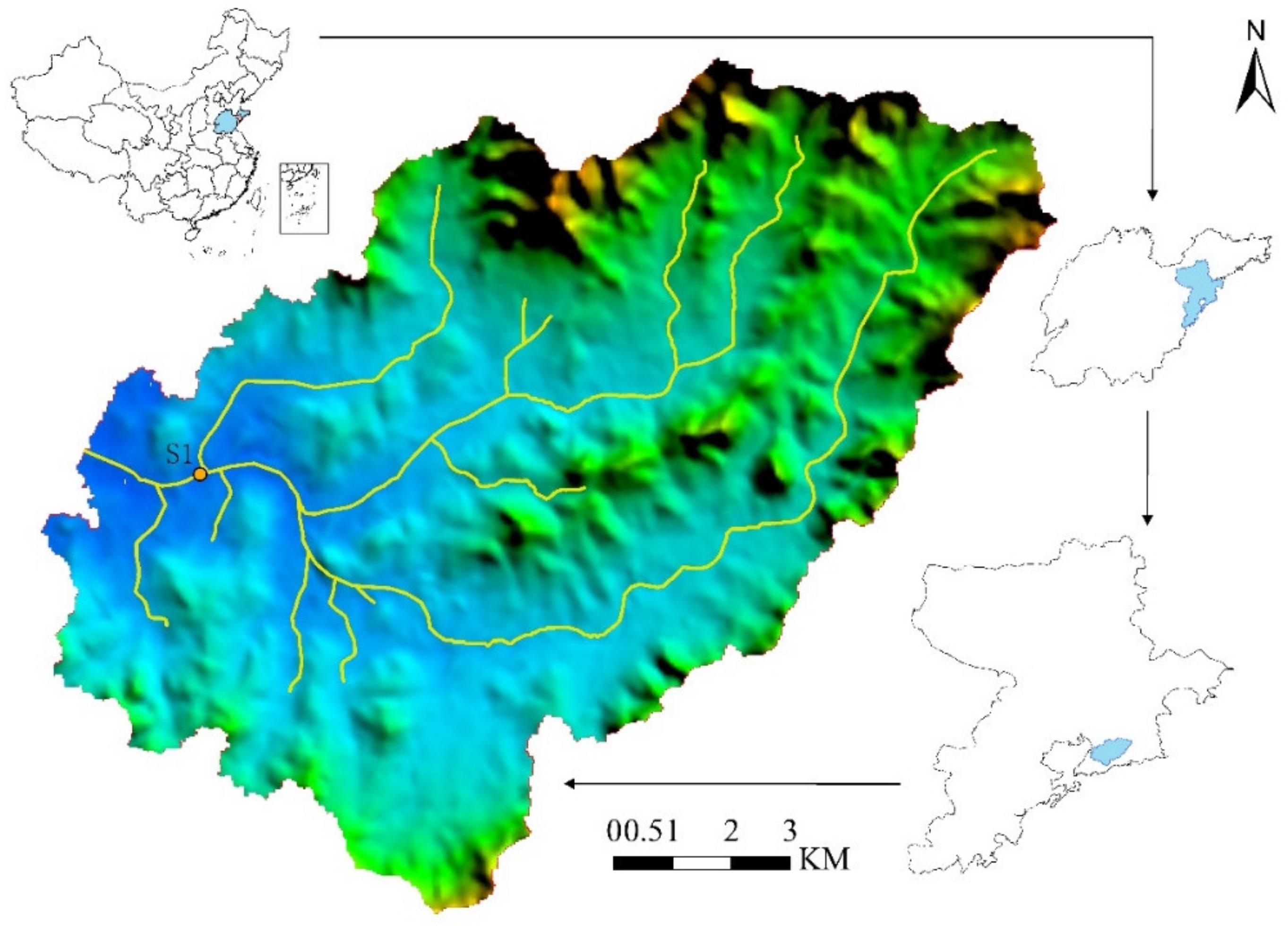
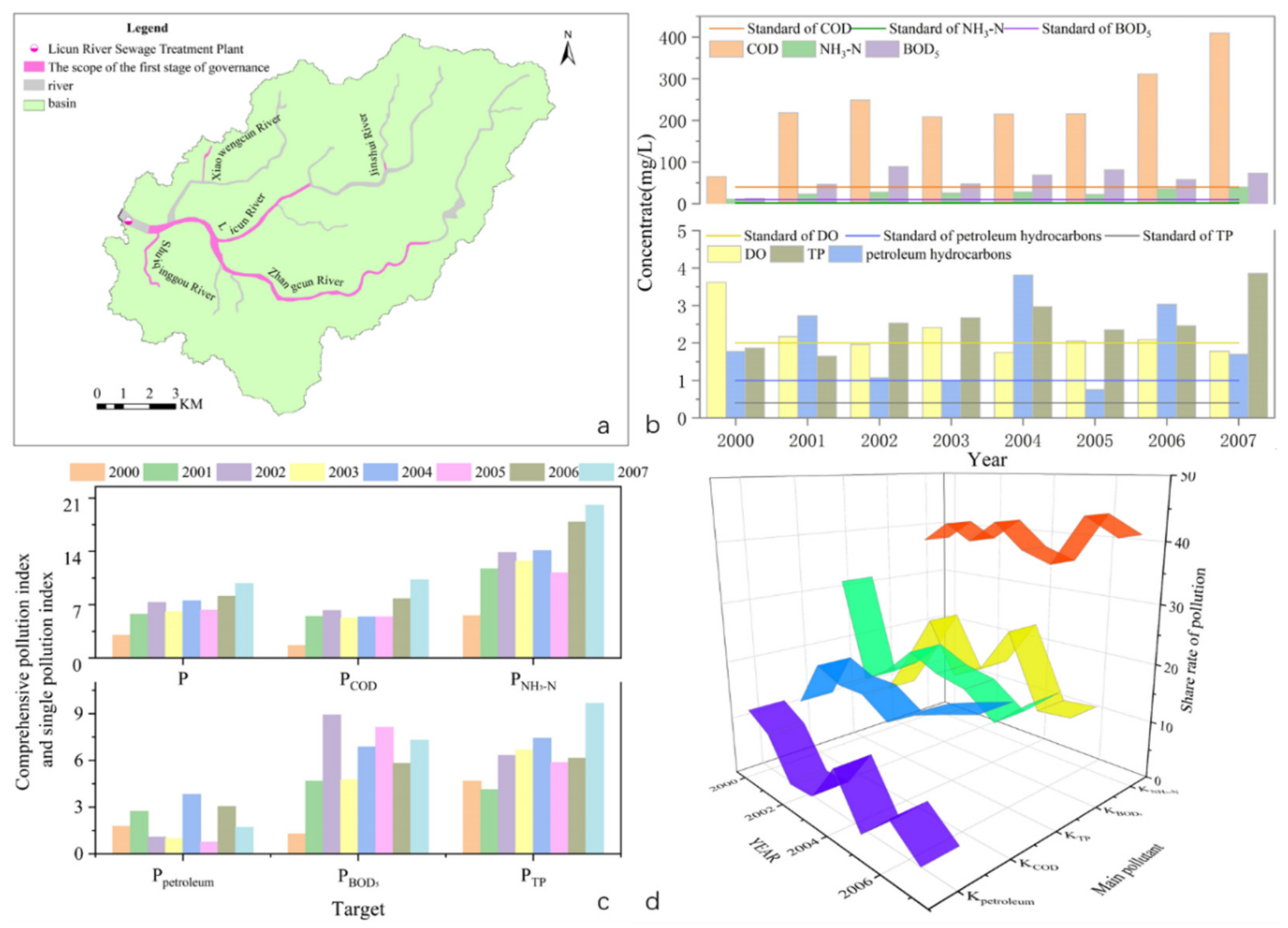
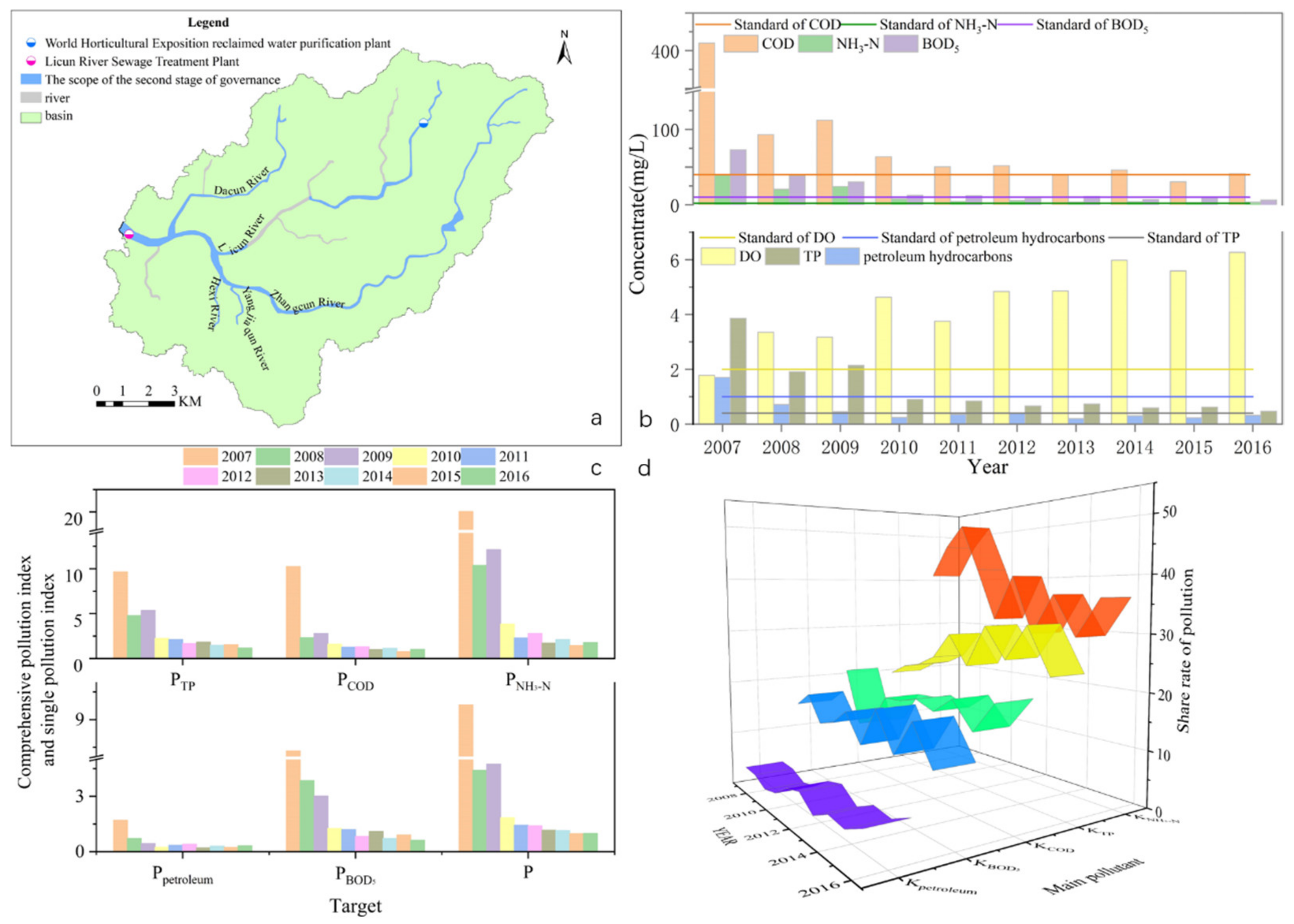
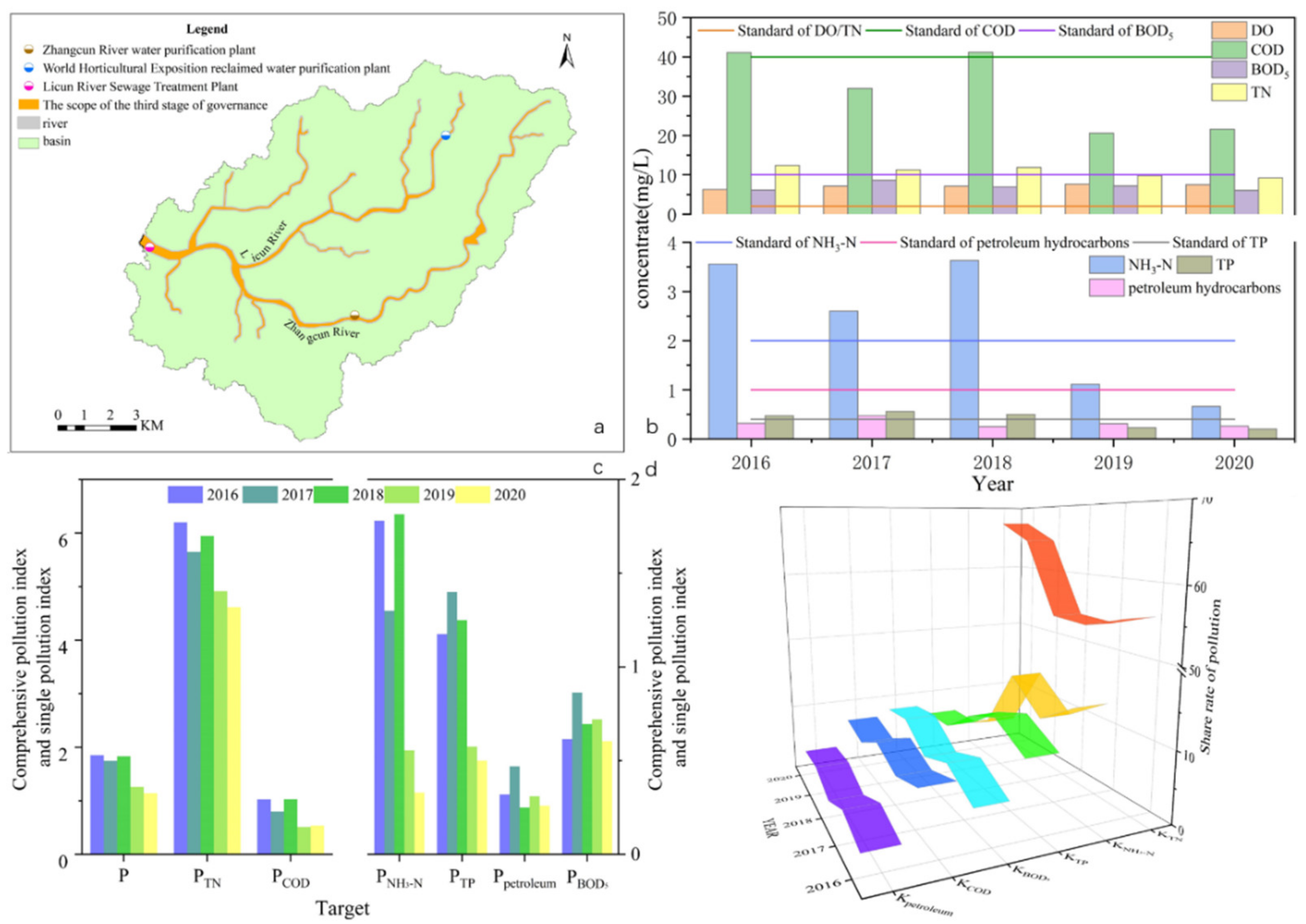

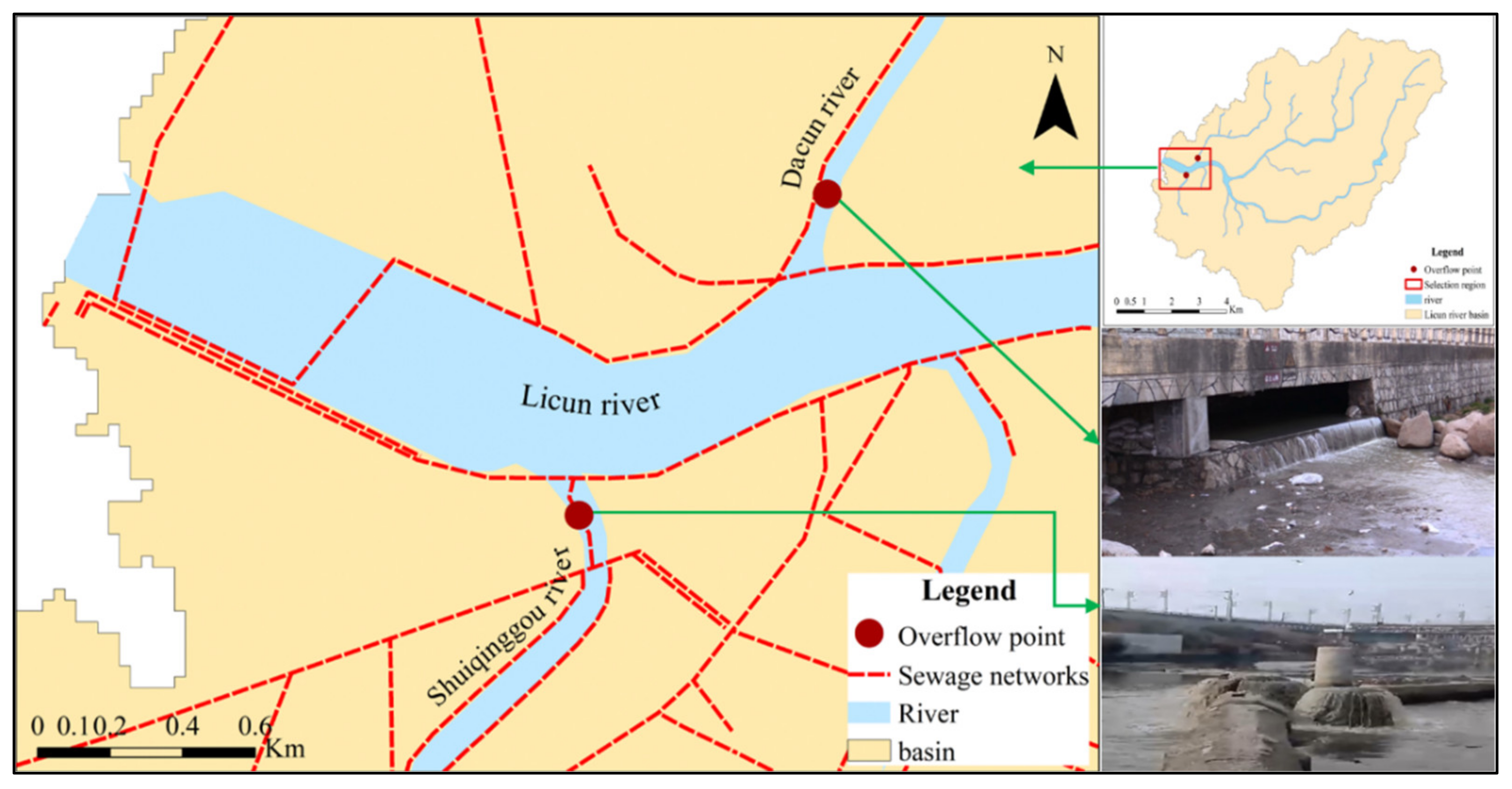
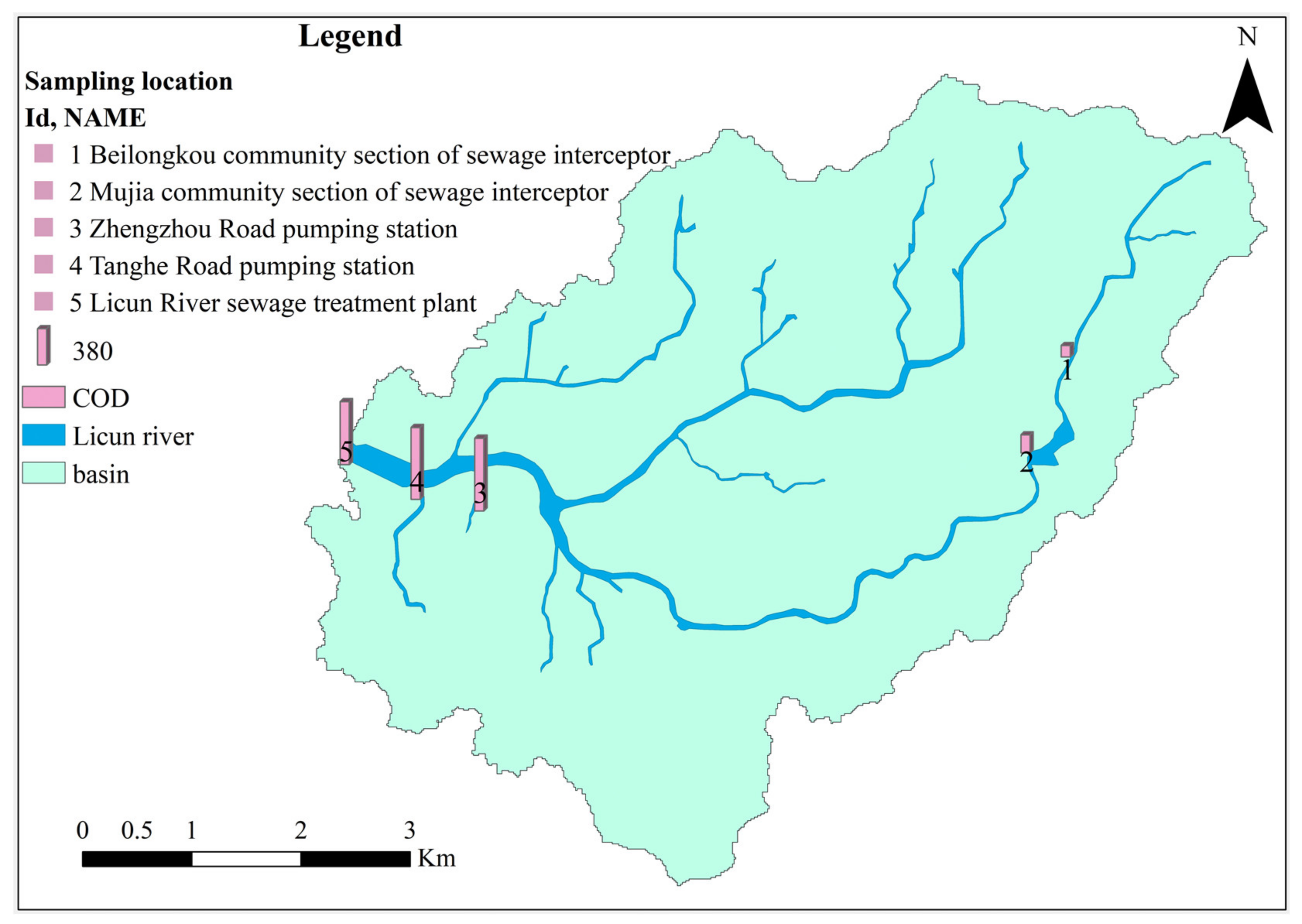
Publisher’s Note: MDPI stays neutral with regard to jurisdictional claims in published maps and institutional affiliations. |
© 2022 by the authors. Licensee MDPI, Basel, Switzerland. This article is an open access article distributed under the terms and conditions of the Creative Commons Attribution (CC BY) license (https://creativecommons.org/licenses/by/4.0/).
Share and Cite
Zhang, M.; Wang, L.; Huang, X.; Zhang, X. Pollution Contribution Response in Governance and Potential Pollution Factors in Licun River. Sustainability 2022, 14, 3547. https://doi.org/10.3390/su14063547
Zhang M, Wang L, Huang X, Zhang X. Pollution Contribution Response in Governance and Potential Pollution Factors in Licun River. Sustainability. 2022; 14(6):3547. https://doi.org/10.3390/su14063547
Chicago/Turabian StyleZhang, Minghui, Lin Wang, Xuda Huang, and Xiaofeng Zhang. 2022. "Pollution Contribution Response in Governance and Potential Pollution Factors in Licun River" Sustainability 14, no. 6: 3547. https://doi.org/10.3390/su14063547
APA StyleZhang, M., Wang, L., Huang, X., & Zhang, X. (2022). Pollution Contribution Response in Governance and Potential Pollution Factors in Licun River. Sustainability, 14(6), 3547. https://doi.org/10.3390/su14063547





